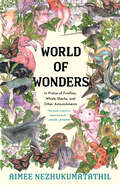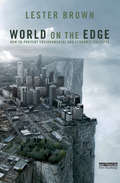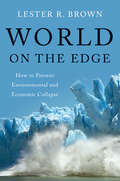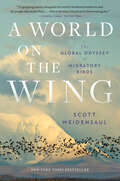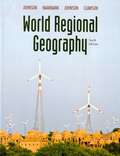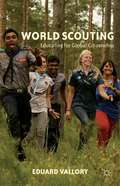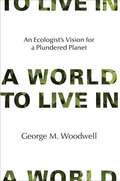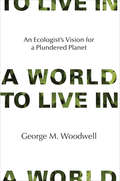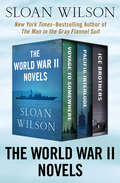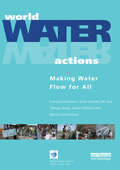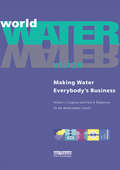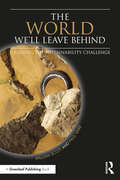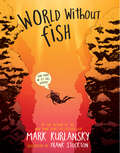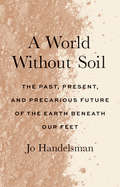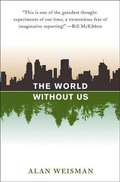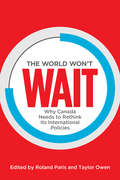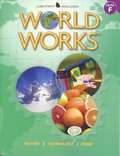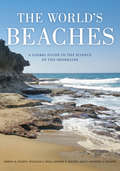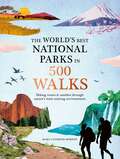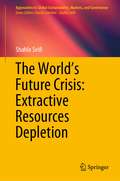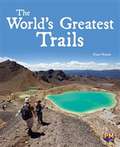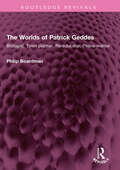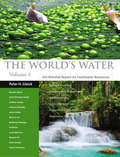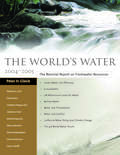- Table View
- List View
World of Wonders: In Praise of Fireflies, Whale Sharks, and Other Astonishments
by Aimee Nezhukumatathil“A poet celebrates the wonders of nature in a collection of essays that could almost serve as a coming-of-age memoir.” —Kirkus ReviewsAs a child, Nezhukumatathil called many places home: the grounds of a Kansas mental institution, where her Filipina mother was a doctor; the open skies and tall mountains of Arizona, where she hiked with her Indian father; and the chillier climes of western New York and Ohio. But no matter where she was transplanted—no matter how awkward the fit or forbidding the landscape—she was able to turn to our world’s fierce and funny creatures for guidance.“What the peacock can do,” she tells us, “is remind you of a home you will run away from and run back to all your life.” The axolotl teaches us to smile, even in the face of unkindness; the touch-me-not plant shows us how to shake off unwanted advances; the narwhal demonstrates how to survive in hostile environments. Even in the strange and the unlovely, Nezhukumatathil finds beauty and kinship. For it is this way with wonder: it requires that we are curious enough to look past the distractions in order to fully appreciate the world’s gifts.Warm, lyrical, and gorgeously illustrated by Fumi Nakamura, World of Wonders is a book of sustenance and joy.Praise for World of WondersBarnes & Noble 2020 Book of the YearAn NPR Best Book of 2020An Esquire Best Book of 2020A Publishers Weekly “Big Indie Book of Fall 2020”A BuzzFeed Best Book of Fall 2020“Hands-down one of the most beautiful books of the year.” —NPR“A timely story about love, identity and belonging.” —New York Times Book Review“A truly wonderous essay collection.” —Roxane Gay, The Audacity
World on the Edge: How to Prevent Environmental and Economic Collapse
by Lester BrownIn this urgent time, World on the Edge calls out the pivotal environmental issues and how to solve them now. We are in a race between political and natural tipping points. Can we close coal-fired power plants fast enough to save the Greenland ice sheet and avoid catastrophic sea level rise? Can we raise water productivity fast enough to halt the depletion of aquifers and avoid water-driven food shortages? Can we cope with peak water and peak oil at the same time? These are some of the issues Lester R. Brown skilfully distils in World on the Edge. Bringing decades of research and analysis into play, he provides the responses needed to reclaim our future.
World on the Edge: How to Prevent Environmental and Economic Collapse
by Lester R. BrownIn this urgent time, World on the Edge calls out the pivotal environmental issues and how to solve them now. We are in a race between political and natural tipping points. Can we close coal-fired power plants fast enough to save the Greenland ice sheet and avoid catastrophic sea level rise? Can we raise water productivity fast enough to halt the depletion of aquifers and avoid water-driven food shortages? Can we cope with peak water and peak oil at the same time? These are some of the issues Lester R. Brown skillfully distills in World on the Edge. Bringing decades of research and analysis into play, he provides the responses needed to reclaim our future.
A World on the Wing: The Global Odyssey Of Migratory Birds
by Scott WeidensaulNew York Times Bestseller Finalist for the Los Angeles Times Book Prize A Library Journal Best Science and Technology Book of the Year An exhilarating exploration of the science and wonder of global bird migration. In the past two decades, our understanding of the navigational and physiological feats that enable birds to cross immense oceans, fly above the highest mountains, or remain in unbroken flight for months at a stretch has exploded. What we’ve learned of these key migrations—how billions of birds circumnavigate the globe, flying tens of thousands of miles between hemispheres on an annual basis—is nothing short of extraordinary. Bird migration entails almost unfathomable endurance, like a sparrow-sized sandpiper that will fly nonstop from Canada to Venezuela—the equivalent of running 126 consecutive marathons without food, water, or rest—avoiding dehydration by "drinking" moisture from its own muscles and organs, while orienting itself using the earth’s magnetic field through a form of quantum entanglement that made Einstein queasy. Crossing the Pacific Ocean in nine days of nonstop flight, as some birds do, leaves little time for sleep, but migrants can put half their brains to sleep for a few seconds at a time, alternating sides—and their reaction time actually improves. These and other revelations convey both the wonder of bird migration and its global sweep, from the mudflats of the Yellow Sea in China to the remote mountains of northeastern India to the dusty hills of southern Cyprus. This breathtaking work of nature writing from Pulitzer Prize finalist Scott Weidensaul also introduces readers to those scientists, researchers, and bird lovers trying to preserve global migratory patterns in the face of climate change and other environmental challenges. Drawing on his own extensive fieldwork, in A World on the Wing Weidensaul unveils with dazzling prose the miracle of nature taking place over our heads.
World Regional Geography (10th edition)
by David L. Clawson Merrill L. Johnson Douglas L. Johnson Viola HaarmannPulling from an impressive team of ten authors, each chapter in this book has been authored by an expert in the region to provide the utmost accuracy and relevancy. World Regional Geography explores the character of the world's people, with a central theme of human development, for an issues-oriented overview of each region. An emphasis on subregions (places within regions) enables readers to explore specific locales. An economic development theme offers a more conceptual treatment than the traditional coverage of this topic. Basic Concepts and Ideas; The United States and Canada; Latin America and the Caribbean; Europe; Northern Eurasia; Central Asia and Afghanistan; The Middle East and North Africa; Africa South of the Sahara; South Asia; East Asia; Southeast Asia; Australia, New Zealand, and the Pacific Islands. The useful references for anyone who wants to learn more about the different regions of the world.
World Scouting
by Eduard ValloryThis is the very first book to look at scouting worldwide and explain in a comprehensible way the largest youth movement on the planet, with a presence in over 165 countries on 5 continents. Based on the first academic research on world scouting, it covers the history of boy and girl scouting from its origins to the present, its structure and recognition policy, and its role in developing ideas of global citizenship and belonging. Using new data and storytelling, Eduard Vallory discusses the main elements that distinguish the scout movement all over the world; explains its origin, evolution, operating system, and values; and deals with its controversies.
A World to Live In
by George M. WoodwellA century of industrial development is the briefest of moments in the half billion years of the earth's evolution. And yet our current era has brought greater changes to the earth than any period in human history. The biosphere, the globe's life-giving envelope of air and climate, has been changed irreparably. In A World to Live In, the distinguished ecologist George Woodwell shows that the biosphere is now a global human protectorate and that its integrity of structure and function are tied closely to the human future. The earth is a living system, Woodwell explains, and its stability is threatened by human disruption. Industry dumps its waste globally and makes a profit from it, invading the global commons; corporate interests overpower weak or nonexistent governmental protection to plunder the planet. The fossil fuels industry offers the most dramatic example of environmental destruction, disseminating the heat-trapping gases that are now warming the earth and changing the climate forever. The assumption that we can continue to use fossil fuels and "adapt" to climate disruption, Woodwell argues, is a ticket to catastrophe.But Woodwell points the way toward a solution. We must respect the full range of life on earth -- not species alone, but their natural communities of plant and animal life that have built, and still maintain, the biosphere. We must recognize that the earth's living systems are our heritage and that the preservation of the integrity of a finite biosphere is a necessity and an inviolable human right.
A World to Live In: An Ecologist's Vision for a Plundered Planet
by George M. WoodwellA scientist makes a powerful case that preservation of the integrity of the biosphere is a necessity and an inviolable human right.A century of industrial development is the briefest of moments in the half billion years of the earth's evolution. And yet our current era has brought greater changes to the earth than any period in human history. The biosphere, the globe's life-giving envelope of air and climate, has been changed irreparably. In A World to Live In, the distinguished ecologist George Woodwell shows that the biosphere is now a global human protectorate and that its integrity of structure and function are tied closely to the human future. The earth is a living system, Woodwell explains, and its stability is threatened by human disruption. Industry dumps its waste globally and makes a profit from it, invading the global commons; corporate interests overpower weak or nonexistent governmental protection to plunder the planet. The fossil fuels industry offers the most dramatic example of environmental destruction, disseminating the heat-trapping gases that are now warming the earth and changing the climate forever. The assumption that we can continue to use fossil fuels and “adapt” to climate disruption, Woodwell argues, is a ticket to catastrophe.But Woodwell points the way toward a solution. We must respect the full range of life on earth—not species alone, but their natural communities of plant and animal life that have built, and still maintain, the biosphere. We must recognize that the earth's living systems are our heritage and that the preservation of the integrity of a finite biosphere is a necessity and an inviolable human right.
The World War II Novels: Voyage to Somewhere, Pacific Interlude, and Ice Brothers
by Sloan WilsonThree novels of life at sea during World War II from the bestselling author of The Man in the Gray Flannel Suit and A Summer Place. Drawing on his own experiences as a US Coast Guard officer, Sloan Wilson sheds a unique light on World War II in these three unforgettable novels. Voyage to Somewhere: Hoping to draw a nice, lengthy shore duty after two years at sea, Lieutenant Barton is instead told that he’s being sent right back out, this time as captain of a supply ship sailing from California to New Guinea and stopping at every small island in between. Despite being homesick for his wife, he has no choice but to accept the assignment and a cargo of pineapples destined for Hawaii. When Barton isn’t battling gale-force winds and monstrous waves, he’s coping with seasick sailors and budding rivalries that threaten to turn mutinous. Hanging over the ship like a storm cloud is the knowledge that the world is at war and the enemy is never far away. “One of the few honest and straightforward sea books that have come out of the war” (New York Herald Tribune).Pacific Interlude: Twenty-five-year-old Coast Guard lieutenant Sylvester Grant, a veteran of the Greenland Patrol, has just been given command of a small gas tanker carrying extremely flammable cargo across dangerous stretches of the Pacific Ocean. As the Allies prepare to retake the Philippines, Grant and his crew must bring two hundred thousand gallons of high-octane aviation fuel to shore. From below-deck personality clashes to the terrifying possibility of an enemy attack, from combating illness and boredom to the constant stress of preventing a deadly explosion, the crew of Y-18 must learn to work together and trust their captain—otherwise, they might never make it home. “Powerful, passionate and authentic . . . Unforgettable” (James Dickey, author of Deliverance). Ice Brothers: After the attack on Pearl Harbor, Paul Schuman, a college senior and summer sailor, enlists in the Coast Guard and is assigned to be the executive officer aboard the Arluk, a converted fishing trawler patrolling the coast of Greenland for secret German weather bases. Led by Lt. Cdr. “Mad” Mowry, the finest ice pilot and meanest drunk in the Coast Guard, Schuman and communications officer Nathan Greenberg battle deadly icebergs, dangerous blizzards, and menacing Nazi gunboats. Surviving the war will require every ounce of courage and intelligence they possess—and that’s before Mowry breaks, forcing the young officers to take command at the worst possible moment. “The best since The Caine Mutiny” (San Francisco Chronicle).
World Water Actions: Making Water Flow for All
by Francois GuerquinThis text is divided into three parts. Part I focuses on the need for management to assess the challenges of water scarcity and plan changes based on proper valuation and financial instruments, international co-operation and efficient use. Part II analyses the problems of water scarcity and the available solutions in each main sector: water supply and sanitation, energy, health, agriculture, ecosystems and biodiversity. Part III assesses the state of the debate following the third World Water Forum and sets out the priorities for action, including increased investment, institutional reform and capacity building in the water sector. Downloadable resources with extensive case studies and statistical data accompanies this text.
World Water Vision: Making Water Everybody's Business
by William J. Cosgrove Frank R. RijsbermanMore than a billion people cannot get safe drinking water; half the world's population does not have adequate sanitation; within a generation over three billion will be suffering from water stress. This text analyzes the issues in this crisis of management and shows how water can be used effectively and productively. The key to sustainable water resources is an integrated approach. The authors assert that careful planning and concerted action can make the fundamental changes needed and that the implications of not dealing with the crisis are immense. The book comes with a CD ROM containing background research and scenarios.
The World We'll Leave Behind: Grasping the Sustainability Challenge
by William Scott Paul VareIt is now clear that human activity has influenced how the biosphere supports life on Earth, and given rise to a set of connected environmental and social problems. In response to the challenge that these problems present, a series of international conferences and summits led to discussions of sustainable development and the core dilemma of our time: How can we all live well, now and in the future, without compromising the ability of the planet to enable us all to live well? This book identifies the main issues and challenges we now face; it explains the ideas that underpin them and their interconnection, and discusses a range of strategies through which they might be addressed and possibly resolved. These cover things that governments might do, what businesses and large organisations can contribute, and the scope for individuals, families and communities to get involved. This book is for everyone who cares about such challenges, and wants to know more about them.
World Without Fish
by Frank Stockton Mark Kurlansky"Can you imagine a world without fish? It's not as crazy as it sounds. But if we keep doing things the way we've been doing things, fish could become extinct within fifty years. So let's change the way we do things!" Announcing the paperback edition of World Without Fish, the uniquely illustrated narrative nonfiction account—for kids—of what is happening to the world’s oceans and what they can do about it. Written by Mark Kurlansky, the bestselling author of Cod, Salt, The Big Oyster, and many other books, World Without Fish has been praised as “urgent” (Publishers Weekly) and “a wonderfully fast-paced and engaging primer on the key questions surrounding fish and the sea” (Paul Greenberg, author of Four Fish).?It has also been included in the New York State Expeditionary Learning English Language Arts Curriculum. Written by a master storyteller, World Without Fish connects all the dots—biology, economics, evolution, politics, climate, history, culture, food, and nutrition—in a way that kids can really understand. It describes how the fish we most commonly eat, including tuna, salmon, cod, swordfish—even anchovies— could disappear within fifty years, and the domino effect it would have: the oceans teeming with jellyfish and turning pinkish orange from algal blooms, the seabirds disappearing, then reptiles, then mammals. It describes the back-and-forth dynamic of fishermen, who are the original environmentalists, and scientists, who not that long ago considered fish an endless resource. It explains why fish farming is not the answer—and why sustainable fishing is, and how to help return the oceans to their natural ecological balance. Interwoven with the book is a twelve-page full-color graphic novel. Each beautifully illustrated chapter opener links to the next to form a larger fictional story that perfectly complements the text.
A World Without Soil: The Past, Present, and Precarious Future of the Earth Beneath Our Feet
by Jo HandelsmanA celebrated biologist's manifesto addressing a soil loss crisis accelerated by poor conservation practices and climate change &“Jo Handelsman is a national treasure, and her clarion call warning of a looming soil-loss catastrophe must be heard. Add her clearly written alarm to other future-shocks: climate change, pandemics, and mass extinctions.&”—Laurie Garrett, Pulitzer Prize winner and author of The Coming Plague: Newly Emerging Diseases in a World out of Balance &“The ground beneath our feet is slipping away as we lose the precious soil that sustains us. Jo Handelsman&’s writing—as rich and life supporting as the soil itself—is a riveting warning.&”—Alan Alda, actor, writer, and host of the podcast &“Clear+Vivid with Alan Alda&” This book by celebrated biologist Jo Handelsman lays bare the complex connections among climate change, soil erosion, food and water security, and drug discovery. Humans depend on soil for 95 percent of global food production, yet let it erode at unsustainable rates. In the United States, China, and India, vast tracts of farmland will be barren of topsoil within this century. The combination of intensifying erosion caused by climate change and the increasing food needs of a growing world population is creating a desperate need for solutions to this crisis. Writing for a nonspecialist audience, Jo Handelsman celebrates the capacities of soil and explores the soil-related challenges of the near future. She begins by telling soil&’s origin story, explains how it erodes and the subsequent repercussions worldwide, and offers solutions. She considers lessons learned from indigenous people who have sustainably farmed the same land for thousands of years, practices developed for large-scale agriculture, and proposals using technology and policy initiatives.
The World Without Us
by Alan WeismanWhat would happen to the Earth if all humans vanished one day? What would collapse first? Which items would be immortalized as fossils? How much capacity for self-healing does the Earth have?
The World Won't Wait
by Roland Paris Taylor OwenThe need for an ambitious and forward-looking Canadian international strategy has never been greater. The worldwide changes that jeopardize Canadian security and prosperity are profound, ranging from the globalization of commerce, crime, and political extremism to the impact of climate change on the economy and environment. The reaction from Canada's policymakers, at least so far, has been underwhelming.In The World Won't Wait, some of Canada's brightest thinkers respond. Covering both classic foreign policy issues such as international security, human rights, and global institutions and emerging issues like internet governance, climate change, and sustainable development, their essays offer fresh and provocative responses to today's challenges and opportunities. The proposals are striking and the contributors diverse: Toronto's chief city planner makes the case that Canada needs a global urban agenda, while a prominent mining executive explains how to revitalize the country's position as a world leader in the sector. Their essays are sure to spark the kind of debate that Canada requires if its international policy is to evolve into the twenty-first century.
World Works, Level F: Nature, Technology, Food
by McGraw-HillExplore how things work through high-interest, engaging informational nonfiction!Improve reading comprehension of informational nonfiction, encourage student inquiry with high-interest topics, and prepare students for high-stakes assessments with the World WorksTM series from Jamestown Education. World WorksTM brings the world to life. Each four-color, consumable book of the 6-book series features 9 informational articles focused on how things work. Each unit within a book covers one of the following topics; Everyday Things, Law, Health, Food, Technology, or Nature. All categories are covered at each reading level. Each article answers the question, "How Does it Work?" Each informational article includes a graph, chart, or diagram, along with an after-reading critical-thinking questions on interpreting charts and graphs.
The World's Beaches
by Orrin H. Pilkey William J. Neal James Andrew Cooper Joseph T. KelleyTake this book to the beach; it will open up a whole new world. Illustrated throughout with color photographs, maps, and graphics, it explores one of the planet's most dynamic environments--from tourist beaches to Arctic beaches strewn with ice chunks to steaming hot tropical shores. The World's Beaches tells how beaches work, explains why they vary so much, and shows how dramatic changes can occur on them in a matter of hours. It discusses tides, waves, and wind; the patterns of dunes, washover fans, and wrack lines; and the shape of berms, bars, shell lags, cusps, ripples, and blisters. What is the world's longest beach? Why do some beaches sing when you walk on them? Why do some have dark rings on their surface and tiny holes scattered far and wide? This fascinating, comprehensive guide also considers the future of beaches, and explains how extensively people have affected them--from coastal engineering to pollution, oil spills, and rising sea levels.
The World's Best National Parks in 500 Walks (500 Walks)
by Mary Caperton MortonAn inspiring and practical reference guide for hikers of all abilities who want to explore the world&’s national parks.Ever since Yellowstone National Park was established in 1872 as the world&’s first national park, the movement to preserve natural landscapes and habitats has spread to every continent. The World&’s Best National Parks in 500 Walks is the perfect inspiration for every explorer, from the armchair traveler to the veteran hiker, with full-color photos and vivid descriptions of some of the world&’s most spectacular hiking trails. Helpful tips on navigating the routes, planning your trips, and preparing for encounters with wildlife will have you lacing up your boots and strapping on your backpack, whether it&’s for a short weekday stroll or a multiday expedition on the world&’s most breathtaking trails.
The World’s Future Crisis: Extractive Resources Depletion (Approaches to Global Sustainability, Markets, and Governance)
by Shahla SeifiThis book focuses mainly on strategic decision making at a global level, which is rarely considered in approaches to sustainability. This book makes a unique contribution as the work looks at global consequences of mineral exhaustion and steps that can be taken to alleviate the impending problems. This book highlights how sustainability has become one of the most important issues for businesses, governments and society at large. This book explores the topic of sustainability as one that is under much debate as to what it actually is and how it can be achieved, but it is completely evident that the resources of the planet are fixed in quantity, and once used, cannot be reused except through being reused in one form or another. This is particularly true of the mineral resources of the planet. These are finite in quantity, and once fully extracted, extra quantities are no longer available for future use. This book argues and presents evidence that the remaining mineral resources are diminishing significantly and heading towards exhaustion. Once mined and consumed, they are no longer available for future use other than what can be recycled and reused. This book demonstrates that future scarcity means that best use must be made of what exists, as sustainability depends upon this, and best use is defined as utility rather than economic value, which must be considered at a global level rather than a national level. Moreover, sustainability depends upon both availability in the present and in the future, so the use of resources requires attention to the future as well as to the present. This book investigates the alternative methods of achieving the global distribution of these mineral resources and proposes an optimum solution. This book adds to the discourse through the understanding of the importance of the depletion and finiteness of raw materials and their use for the present and the future, in order to achieve and maintain sustainability.
The World's Greatest Trails (Into Reading, Level P #56)
by Diana NoonanNIMAC-sourced textbook <p><p> Hiking is a pastime enjoyed by people all over the world. Many countries have hiking trails that are famous for their length, scenery, or wildlife. Read all about some of the world's greatest trails!
The World's Largest Plants: A Book About Trees
by Susan BlackabyHear the wind rustling through the maple? See the rings on the old tree trunk? Come along on a vivid introduction to the majestic giants of the plant world.
The Worlds of Patrick Geddes: Biologist, Town planner, Re-educator, Peace-warrior (Routledge Revivals)
by Philip BoardmanFirst published in 1978, The Worlds of Patrick Geddes is a study of Patrick Geddes’ thought and action, his relationships and his life, as someone who defied labelling and who was years ahead of his contemporaries. The work of Patrick Geddes (1854-1932) is coming to be more and more widely appreciated, as his ideas on many diverse subjects are being gradually assimilated into the mainstream of modern thought. Geddes has been confidently labelled as a biologist, town-planner, sociologist and educator; but he was all of these and more. This book will be of interest to students of biology, urban planning and sociology.
The World's Water
by Peter H. GleickAmong the most compelling environmental issues of today and tomorrow are those concerning the world's fresh water resources. Peter H. Gleick's important new volume, Water in Crisis, addresses the timely and sometimes controversial aspects of world water use. At stake are water quality, quantity, and possible future conflicts over shared international water resources. Nine essays by leading specialists from fields as diverse as hydrology, zoology, and law, among others, cover such issues as the status of developments in international water law; hydroelectric power; the possible effects of climatic change on water resources; and the state of fresh water fisheries. Particular chapters explore access to clean drinking water and sanitation; the use of water for energy and food production; the quality of rivers, lakes, and inland seas; and the condition of natural aquatic ecosystems. A joint project of the Pacific Institute and the Stockholm Environment Institute, this book is a comprehensive guide to the world's fresh water resources. Hydrologists, engineers, policy makers, professionals in the environmental sciences, as well as lay readers will find Water in Crisis a dynamic resource and information-packed reference. More than 200 tables of fresh water data supplement this important volume.
The World's Water 2004-2005: The Biennial Report on Freshwater Resources (The World's Water)
by Peter H. Gleick Pacific Institute Catherine Hunt Dana Haasz Nicholas L. Cain Christine Henges-JeckThe quality and availability of fresh water are of critical importance to human and ecosystem health. Given its central role in the functioning of all living systems, water is arguably the most important of all natural resources. Produced biennially, The World's Water provides a timely examination of the key issues surrounding freshwater resources and their use. Each new volume identifies and explains the most significant current trends worldwide, and offers the best data available on a variety of water-related topics. This 2004-2005 edition of The World's Water features overview chapters on: conservation and efficiency as key tools for meeting freshwater needs; bottled water quality, costs, and trends; United Nations millennium development goals; groundwater issues; case studies of water privatization; the economic value of water; California water policy and climate change. The World's Water is the most comprehensive and up-to-date source of information and analysis on freshwater resources and the political, economic, scientific, and technological issues associated with them. It is an essential reference for water resource professionals in government agencies and nongovernmental organizations, researchers, students, and anyone concerned with water and its use.
